Gosbank
Gosbank (Russian: Госбанк, Государственный банк СССР, Gosudarstvenny bank SSSR—the State Bank of the USSR) was the central bank of the Soviet Union and the only bank whatsoever in the entire Union from the 1930s to 1987. Gosbank was one of the three Soviet economic authorities, the other two being "Gosplan" (the State Planning Committee) and "Gossnab" (the State Committee for Material Technical Supply). The Gosbank closely collaborated with the Ministry of Finance of the USSR to prepare the national state budget.

 | |
| Headquarters | 12 Neglinnaya str., Moscow, Soviet Union |
|---|---|
| Established | 1922 |
| Central bank of | |
| Currency | Soviet ruble SUR (ISO 4217) |
| Preceded by | State Bank of the Russian Empire (1860–1917/1922) |
| Succeeded by | Bank of Russia (1991–present) |
Foundation
| Part of a series on |
| Soviet economics |
|---|
|
The foundation of the bank was part of the implementation of the New Economic Policy. On 3 October 1921, the All-Russian Central Executive Committee (VTsIK), passed a resolution for the founding of the State Bank of the Russian Soviet Federative Socialist Republic. This was followed by a similar resolution passed by Sovnarkom on 10 October 1921. It began operations on 16 November 1921. In February 1922 Lenin described the State Bank as a "a bureaucratic paper game", comparing it to a Potemkin village in a letter to Aron Sheinman whom he accused of "Communist-mandarin childishness".[1] In 1923 it was transformed into the State Bank of the USSR. It was placed under the jurisdiction of Narkomfin.[2] The Soviet state used Gosbank, primarily, as a tool to impose centralized control upon industry in general, using bank balances and transaction histories to monitor the activity of individual concerns and their compliance with Five-Year Plans and directives. Gosbank did not act as a commercial bank in regard to the profit motive. It acted, theoretically, as an instrument of government policy. Instead of independently and impartially assessing the creditworthiness of the borrower, Gosbank would provide loan funds to favored individuals, groups and industries as directed by the central government.[3]
In 1931 Boris Berlatsky, a senior official of the State Bank was put on trial for wrecking as part of the 1931 Menshevik Trial.[4]
Perestroika
As part of Mikhail Gorbachev's perestroika program, other banks were formed, including; "Promstroybank" (USSR Bank of Industrial Construction), "Zhilstoybank" (USSR Bank of Residential Construction), "Agrobank" (USSR Agricultural Bank), "Vneshekonombank" (USSR Internal Trade Bank), and "Sberbank" (USSR Savings Bank). "Sberbank" continues to this day as one of Russia's largest banks, retaining senior ex-Gosbank personnel and most of the present Russian government's banking business.
Senior executives
This is the list of the Chairmen of the Board of the State Bank.[2][5]
The Chairman was appointed by the Premier of the Soviet Union.
| № | Name (governor) | Photo | Term of office | Appointed by | |
|---|---|---|---|---|---|
| Start of term | End of term | ||||
| 1 | Aron Sheinman[2] |  |
1921 | 1924 | Vladimir Lenin |
| 2 | Nikolai Tumanov |  |
March 5, 1924 | January 16, 1926 | Alexei Rykov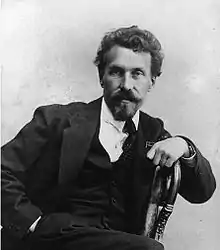 |
| 3 | Georgy Pyatakov | 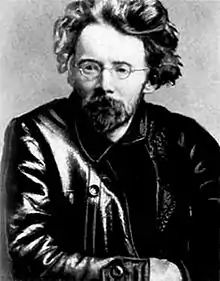 |
April 19, 1929 | October 18, 1930 | |
| 4 | Moissei Kalmanovich |  |
October 18, 1930 | April 4, 1934 | Vyacheslav Molotov |
| 5 | Lev Maryasin |  |
April 4, 1934 | July 14, 1936 | |
| 6 | Solomon Kruglikov |  |
July 14, 1936 | September 15, 1937 | |
| 7 | Alexey Grichmanov |  |
September 15, 1937 | July 16, 1938 | |
| 8 | Nikolai Bulganin |  |
October 2, 1938 | April 17, 1940 | |
| 9 | Nikolai K. Sokolov |  |
April 17, 1940 | October 12, 1940 | |
| 10 | N. Bulganin |  |
October 12, 1940 | May 23, 1945 | Joseph Stalin |
| 11 | Yakov Golev |  |
May 23, 1945 | March 23, 1948 | |
| 12 | Vasily Popov |  |
March 23, 1948 | March 31, 1958 | Georgy Malenkov and Nikolai Bulganin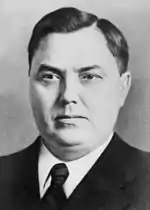  |
| 13 | N. Bulganin |  |
March 31, 1958 | August 15, 1958 | Nikita Khrushchev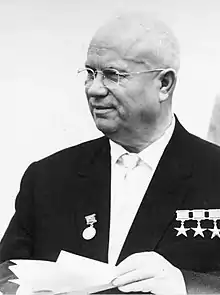 |
| 14 | Alexander Korovushkin |  |
August 15, 1958 | August 14, 1963 | |
| 15 | Alexey Poskonov |  |
1963 | 1969 | Alexei Kosygin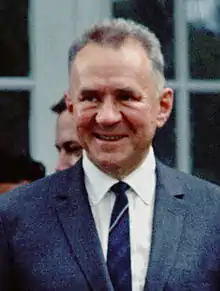 |
| 16 | Miefodiy Svieshnikov |  |
1969 | 1976 | |
| 17 | Vladimir Alkhimov |  |
October 11, 1976 | January 10, 1986 | Nikolai Tikhonov |
| 18 | Viktor Dementsev |  |
January 10, 1986 | August 22, 1987 | Nikolai Ryzhkov |
| 19 | Nikolai Garetovsky |  |
August 22, 1987 | June 7, 1989 | |
| 20 | Viktor Gerashchenko |  |
June 7, 1989 | August 26, 1991 | Valentin Pavlov |
| 21 | Andrei Zverev |  |
August 26, 1991 | December 20, 1991 | Ivan Silayev |
See also
References
- Lenin, Vladimir (1922). Letter to A. L. Sheinman. Progress Publishers. Retrieved 26 May 2015.
- "The State Bank of the USSR". Bank of Russia Today. Bank of Russia. Retrieved 26 May 2015.
- Russia's Road To Corruption
- Jasny, Naum (1972). Soviet Economists of the Twenties. London: Cambridge University Press.
- "ГОСУДАРСТВЕННЫЙ БАНК СССР" [State Bank of the USSR]. СОВНАРКОМ, СОВМИН, КАБМИН СССР 1923-1991 гг. (SOVNARKOM, SOVMIN, CABMIN of the USSR 1923-1991) (in Russian). Archived from the original on 14 April 2016. Retrieved 24 January 2020.
External links
- Soviet Banking System, Pekka Sutela, Answers.com (accessed 2012-08-02)
- Nikolai Rovinsky (1944). "The State Budget of the USSR". (in Russian)